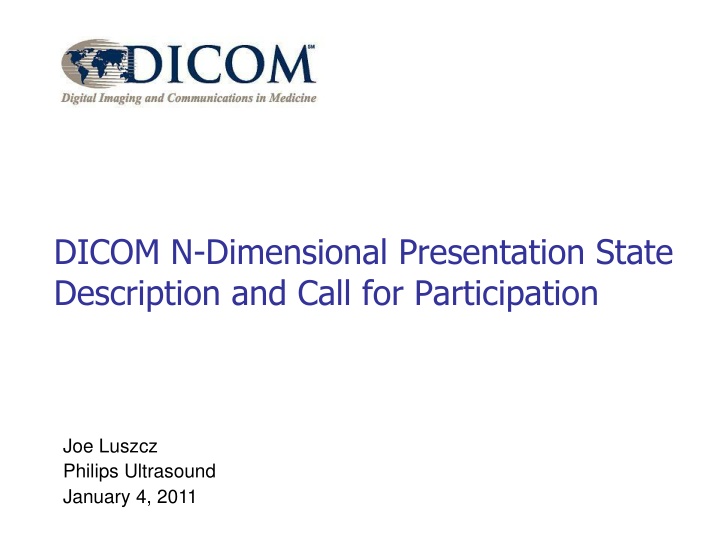
DICOM Presentation State and Enhanced Objects
Explore the concept of DICOM presentation state, which describes how data objects are displayed, including 2D capabilities such as grayscale space, color output, contrast transformations, selection areas, and annotations. Additionally, learn about the application of presentation state attributes and the impact of enhanced DICOM objects on viewing 3D and 4D datasets generated by various imaging modalities.
Download Presentation

Please find below an Image/Link to download the presentation.
The content on the website is provided AS IS for your information and personal use only. It may not be sold, licensed, or shared on other websites without obtaining consent from the author. If you encounter any issues during the download, it is possible that the publisher has removed the file from their server.
You are allowed to download the files provided on this website for personal or commercial use, subject to the condition that they are used lawfully. All files are the property of their respective owners.
The content on the website is provided AS IS for your information and personal use only. It may not be sold, licensed, or shared on other websites without obtaining consent from the author.
E N D
Presentation Transcript
DICOM N-Dimensional Presentation State Description and Call for Participation Joe Luszcz Philips Ultrasound January 4, 2011
What is Presentation State? A recipe describing a particular presentation (display) of a data object. According to DICOM, 2D Presentation State includes capabilities for specifying: the output grayscale space in P-Values the color output space as PCS-Values grayscale contrast transformations including modality, VOI and presentation LUT mask subtraction for multi-frame grayscale images selection of the area of the image to display and whether to rotate or flip it image and display relative annotations, including graphics, text and overlays the blending of two image sets into a single presentation 2
2D Example: Blending Presentation State Pipeline Device Independent Values Window or VOI LUT Rescale Slope/Intercept Underlying Image Grayscale Stored Pixel Values Relative Opacity ICC Input Profile Modality LUT Transformation VOI LUT Transformation Profile Connection Space Transformation Pseudo Color Blending Operation PCS-Values Superimposed Image Grayscale Stored Pixel Values Modality LUT Transformation Palette Color LUT Transformation VOI LUT Transformation 3
Application of Presentation State Data objects may contain certain attributes as a default Presentation State A separate Presentation State object referencing the data object overrides the default presentation state attributes within the referenced data object 4
Enhanced DICOM Objects change the game Many modalities have created Enhanced data objects which allow the specification of 3D and 4D data sets (MR, CT, XA, PET, US, ) These 3D/4D datasets may be presented (viewed) as A collection of spatially-related frames Displayed one at a time, as in a light box display Sequentially, in fly-through display A Multi-Planar Reformatting (MPR) view, which is a derived slice obliquely through the volume dataset Volume Rendering, which is a view of the volume dataset from a specified viewport and orientation 5
Example: Ultrasound Display 3 MPR + Volume Rendering Views 6
3D Workflow These derived views may be exchanged as 2D objects linked to the source volume data objects Need a way to represent the recipe for creating these 2D views of volume data objects so the viewing operation may be replicated on a different system and/or at a different time 7
Example 3D Image Review Workflow Clinician reviews a 2D derived view on a PACS Decides to reposition the slice or viewport or change processing 2D object links to the Presentation State object, which provides the recipe and a link to the source volume data Workstation uses the recipe to regenerate the same 2D view Clinician uses workstation controls to modify presentation parameters starting from the same point as the original 2D view 8
Whats happening within DICOM working groups Working Group 11 (Presentation State) has a work item to create a general (not modality specific) n-Dimensional Presentation State object Working Groups 2 (X-Ray Angiography) and 12 (Ultrasound) are collaborating Need to understand use cases and requirements for all DICOM imaging modalities Other imaging modalities need to participate if they want a say in the creation of nD PS objects 9
Ultrasound Requirements for nD Presentation State Display layout Intensity settings Cropping and sculpting Scaling Slicing (MPR) Rendering Enhanced Blending Pipeline (sup43) Text and Graphic Annotation Identification of Anatomic Views 10
Toshibas nD Presentation State Requirements Annotations Segmentation LUT MPR Curvilinear Reformat Volume Rendering Synchronization 11
Standardization Challenges Distinguishing open-system capabilities from proprietary Open: MPR plane position/orientation, Render viewport Proprietary: Certain rendering or edge enhancement algorithms Maximizing similarity of source and review presentations without disclosing trade secrets Maximizing commonality while recognizing unique modality features 12
Standardization Challenges Most Objective Most Interoperable Most Proprietary Least Interoperable Display Layout Single view Multiple MPR set Parallel planes Curvalinear Combination view, such as A,B,C MPR views plus Volume render view Cropping Crop planes Sculpting Mask Segmentation MPR geometry Plane location/orientation MPR view size Slice thickness Curvalinear MPRs Render geometry Viewport Volume of interest Decorations Graphics Text Anatomic View designation Blending Grayscale/color maps Grayscale/color threshold General classification of algorithms Intensity Projection MIP MinIP AveIP Volume Rendering Surface Rendering Opacity maps Order of application of Calculation of Normals Blending to RGB Rendering Lighting model/parameters Slicing algorithms Rendering algorithms Edge Detection algorithms Smoothing algorithms Filtering algorithms Cropping and Sculpting algorithm parameters 13
Call for Participation In the best interest of vendors and clinicians for all modalities to participate Desired minimum level of participation Use Cases Requirements Test Cases Better Participate in Derivation of the Standard 14
References DICOM ps3.4 Annex N: Softcopy Presentation State (2D only) Toshiba White Paper Volumetric Data Elements , 17 May 2010 Ultrasound White Paper Ultrasound nD Presentation State Requirements , 4 Aug 2010 15
